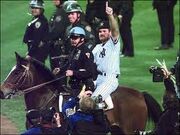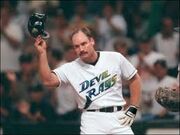Wade Anthony Boggs (born June 15 1958 in Omaha, Nebraska) is a former third baseman in Major League Baseball, primarily with the Boston Red Sox and also with the New York Yankees and Tampa Bay Devil Rays. His hitting in the 1980s and 1990s made him a perennial contender for American League batting titles, in much the same way as his National League contemporary Tony Gwynn. Boggs was elected to the Red Sox Hall of Fame in 2004 and the Baseball Hall of Fame in 2005. With 12 straight All-Star appearances, Boggs is third only to Brooks Robinson and George Brett in number of consecutive appearances as a third baseman. His finest season was 1987 when he set career highs in HR(24), RBI(89), and slugging percentage (.588). Also in that season he batted .363 and held a .461 OBP, both stats leading the league. In 1999, he ranked number 95 on The Sporting News list of the 100 Greatest Baseball Players, and was a nominee for the Major League Baseball All-Century Team.
He currently resides in the Tampa, Florida neighborhood of Tampa Palms.
Minor league career[]
Boggs played in the longest game in professional baseball history as a member of the Pawtucket Red Sox in 1981 against Cal Ripken Jr. and the Rochester Red Wings.
Major league career[]

Wade Boggs with the Red Sox.
A left-handed hitter, Boggs won five batting titles starting in 1983. He also batted .349 in his rookie year which would have won the batting title, but was 121 plate appearances short of the required minimum of 502. From 1982 to 1988, Boggs hit below .349 only once, hitting .325 in 1984. From 1983 to 1989, Boggs rattled off seven consecutive seasons in which he collected 200 or more hits, an American League record for consecutive 200-hit seasons that was later matched by Seattle's Ichiro Suzuki. Boggs also had six seasons with 200 or more hits, 100+ runs and 40+ doubles. Although he would not win another batting title after 1988 (his batting title that year broke Bill Madlock's Major League record of four by a third baseman), he regularly appeared among the league leaders in hitting. He was roundly criticized by columnists, opposing players and even his own teammates as being selfish for his focused, methodical approach to hitting.

Wade Boggs riding the horse in the 1996 world series victory lap.
In 1992, Boggs slumped to .259 – one of only three times in his career that he failed to reach .300 – and at the end of the season he left the Red Sox, with whom he had spent his entire career. He was heavily pursued by two teams: the Los Angeles Dodgers and the New York Yankees - he chose the Yankees when they added the third year to the contract that the Dodgers would not offer. Boggs went on to be awarded three straight all-star appearances, had four straight .300-plus seasons and even collected two Gold Glove Awards for his defense.
In 1996, Boggs helped the Yankees to their first World Series title in 18 years. It was the first (and only) World Series title earned by Boggs. He memorably celebrated by jumping on the back of an NYPD horse, touring the field with his index finger in the air - despite his self-professed fear of horses.

Boggs with the Devil Rays.
Boggs signed with the Tampa Bay Devil Rays for the final two seasons of his career, in 1999 collecting his 3,000th hit. Despite his deserved reputation as a singles hitter with limited power, he is the first of the two members of the 3,000-hit club (Derek Jeter is the other member) whose 3,000th hit was a home run.[1] The historic ball was caught in the right field stands of Tropicana Field by Mike Hogan, a sports information director at the University of South Florida, who gave it back to Boggs at the conclusion of the game. Hogan had moved to Tampa just 10 days prior to the event. Boggs retired in 1999 after sustaining a knee injury, leaving with a career batting average of .328 and 3,010 hits.
Boggs is credited with teaching the Yankees their current pitch-selection technique; swinging only at perfect pitches and fouling off close but tough to hit pitches, forcing teams to go to their usually weak bullpens. Before Boggs joined the Yankees, they were 14th in pitches per plate appearance, and 4th and then 1st after he joined. In addition, the Yankees were 12th and 8th in on base percentage the two years prior to Boggs joining the team and 2nd the year he came on board (1993), followed by 1st, 2nd, 3rd, and 1st.
While not unique, among non-pitchers, Boggs also recorded a few innings pitched at the Major League level. His main pitch was a knuckleball, which he allegedly used 16 times (along with one fastball) in one shutout inning of pitching for the Yankees against the Anaheim Angels in a 1997 game.
His own style included mental preparedness techniques including visualizing four at-bats each evening before a game and imagining himself successfully getting four hits.
In 1987, Boggs – who was up for a new contract following the season – hit 24 home runs, easily the most in any year of his career.
In April 7, 2000 his #12 has been retired by the Tampa Bay Rays.[2] Although he has not had his number retired by the Boston Red Sox, he was inducted into the team's Hall of Fame in 2004.[3]
The Margo Adams affair[]
Boggs garnered non-baseball related media attention in 1989 for his four-year extramarital affair with Margo Adams, a California mortgage broker. After Boggs ended the relationship in 1988, Adams filed a $12 million lawsuit for emotional distress and breach of oral contract. She argued that Boggs had verbally agreed to compensate her for lost income and services performed while accompanying Boggs on road trips.[4] Boggs' reputation was further sullied when Adams agreed to an interview with Penthouse magazine in which she discussed intimate details of her time with Boggs.[5] While acknowledging the validity of the affair, Boggs went on the offensive in order to combat the wave of negative press, publicly denying many of the claims made by Adams. Boggs' rebuttal included an appearance on the ABC program 20/20 in which he presented his side of the story to Barbara Walters.[6] In February 1989, an appeals court threw out $11.5 million of the initial lawsuit, ruling that Adams could not seek compensation for emotional distress.[7] The remaining $500,000 was settled out of court later that year for an undisclosed amount.[8]
Hall of Fame plaque cap logo controversy[]
Before his retirement, Boggs was plagued by newspaper reports that the expansion Devil Rays gave him financial compensation in return for selecting a Devil Rays cap for his plaque at the Baseball Hall of Fame, though he has denied that any such condition was part of his contract.[9] In light of those reports (and other rumors that teams were offering number retirement, money or organizational jobs in exchange for the cap designation) the Hall decided in 2001 to change its practice of deferring to players wishes regarding cap logo selection, and reinforced the Hall's authority to determine with which cap the player would be depicted. Wade Boggs was elected to the Baseball Hall of Fame in 2005 by the BBWAA in his first year of eligibility, along with Ryne Sandberg, who was in his 3rd year on the ballot. The Hall decided that Boggs would eventually be depicted wearing a Boston cap for his 2005 induction, despite his acrimonious relationship with Red Sox management. During the Hall of Fame player introductions of the 2008 All-Star Game at Yankee Stadium, he decided to wear the Yankees cap instead.
Superstitions[]
Boggs was known for his superstitions as much as his hitting. He ate chicken before every game (Jim Rice once called Boggs "chicken man"), woke up at the same time every day, took exactly 150 ground balls in practice, took batting practice at 5:17 and ran sprints at 7:17.[1] His route to and from his position in the field beat a path to the home dugout. He drew the Hebrew word "Chai", meaning "life", in the batter's box before each at-bat, though he is not Jewish. Boggs also claimed that his at-bats improved when longtime mistress Margo Adams attended games while not wearing underwear.[10]
Appearances/portrayals in the media[]
- Wade Boggs once guest starred on Cheers (sixth season, "The Bar Wars") as himself.
- He made a guest appearance in an episode of The Simpsons, (Homer at the Bat) in which he was punched out by Barney Gumble after arguing over who was the best Prime Minister in British history (Boggs favored William Pitt the Elder, while Barney backed Lord Palmerston).
- Boggs was portrayed in an episode of Futurama as a head in a sports museum.
- Indie rock band Sebadoh released a compilation of rare recordings entitled "Wade Through the Boggs" to support their 2007 tour.
- Boggs inducted "Mr. Perfect" Curt Hennig into the WWE Hall of Fame on March 31 2007. He had previously appeared in vignettes with Hennig that aired on WWE programming when he was first introduced, and was close friends with Hennig until his death.
Trivia[]
Template:Trivia
- Boggs lost his mother in a car accident in Tampa while he was with the Red Sox. Shortly after her death, Boggs and his father bought a fish camp in Hawthorne, Florida on Lake Lochloosa they called FinWay which his father ran until shortly before he died.
Bibliography[]
- Boggs! (Amazon ), Contemporary Books, 1986. ISBN 0-8092-5063-2.
- The Techniques of Modern Hitting (Amazon ), Perigee Books, 1990. ISBN 0-399-51595-X. (With David Brisson.)
See also[]
- Boston Red Sox Hall of Fame
- List of Major League Baseball Hit Records
- List of Major League Baseball doubles records
- DHL Hometown Heroes
- List of major league players with 2,000 hits
- List of Major League Baseball players with 400 doubles
- List of Major League Baseball players with 1000 runs
- List of Major League Baseball players with 1000 RBI
- 3000 hit club
- List of Major League Baseball batting champions
- List of Major League Baseball runs scored champions
- List of Major League Baseball doubles champions
- Tampa Bay Rays all-time roster
References[]
- ↑ 1.0 1.1 The Ballplayers - Wade Boggs Biography. BaseballLibrary.com. Retrieved on 2008-07-25.
- ↑ Retired Uniform Numbers in the American League. Baseball Almanac.com. Retrieved on 2008-07-25.
- ↑ Red Sox Hall of Fame. RedSox.com. Retrieved on 2008-07-25.
- ↑ THE LAW; At the Bar. New York Times. Retrieved on 2008-07-25.
- ↑ BASEBALL; Gossip Checks In At Red Sox Camp. New York Times. Retrieved on 2008-07-25.
- ↑ SPORTS PEOPLE: BASEBALL; Boggs Speaks Out. New York Times. Retrieved on 2008-07-25.
- ↑ Big Hit for Boggs in Court. New York Times. Retrieved on 2008-07-25.
- ↑ SPORTS PEOPLE: BASEBALL; Boggs Settlement. New York Times. Retrieved on 2008-07-25.
- ↑ "Boggs, Sandberg field queries as new Hall of Famers". www.usatoday.com. USA Today. Retrieved on 2008-05-21.
- ↑ The Rundown. >Wait, Wait, Don't Tell Me. Retrieved on 2008-07-25. NPR. August 6, 2005
External links[]
- Career statistics and player information from Baseball-Reference, or Fangraphs, or The Baseball Cube
- baseballhalloffame.org – Hall of Fame biography page - Note the error in his HR in 1993 and total.
| Accomplishments | |||
|---|---|---|---|
|
